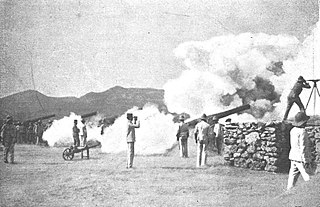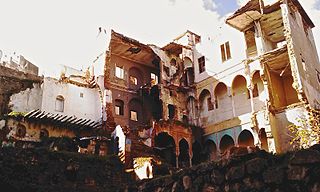
Moulay Ismail Ben Sharif, born around 1645 in Sijilmassa and died on 22 March 1727 at Meknes, was a Sultan of Morocco from 1672–1727, as the second ruler of the Alaouite dynasty. He was the seventh son of Moulay Sharif and was governor of the Kingdom of Fez and the north of Morocco from 1667 until the death of his half-brother, Sultan Moulay Rashid in 1672. He was proclaimed sultan at Fez, but spent several years in conflict with his nephew Moulay Ahmed ben Mehrez, who also claimed the throne, until the latter's death in 1687. Moulay Ismail's 55-year reign is the longest of any sultan of Morocco.

The Alaouite dynasty, also spelled 'Alawi or Alawite dynasty, is the current Moroccan royal family and reigning dynasty. They claim descent from a relative of prophet Muhammad, via Hasan ibn Ali. The name "Alaouite" stemming from the name of the caliph Ali.

The Battle of Alcácer Quibir was fought in northern Morocco, near the town of Ksar-el-Kebir and Larache, on 4 August 1578. The combatants were the army of the deposed Moroccan Sultan Abu Abdallah Mohammed II, with his ally, the King of Portugal Sebastian I, against a large Moroccan army under the new Sultan of Morocco Abd Al-Malik I.
Mohammed Ben Abdellah al-Khatib was Sultan of Morocco from 1757 to 1790 under the Alaouite dynasty. He was the governor of Marrakech around 1750. He was also briefly sultan in 1748. He rebuilt many cities after the earthquake of 1755, including Mogador, Casablanca, and Rabat, and Abdallah Laroui described him as "the architect of modern Morocco." He is notable for having been the leader of one of the first nations to recognize American independence in his alliance with Luis de Unzaga 'le Conciliateur' through correspondence and Unzaga's secret intelligence service and led by his brothers-in-law Antonio and Matías de Gálvez from the Canary Islands.

Mohammed Ben Aarafa, or Ben Arafa, was a paternal first cousin once removed of Sultan Mohammed V of Morocco; he was put in Mohammed V's place by the French after they exiled Mohammed V to Madagascar in August 1953. His reign as "Mohammed VI" was not recognized in the Spanish-protected part of Morocco. Protests against Ben Aarafa helped lead to Moroccan independence, which was agreed to between France and Mohammed V, after his abdication in October 1955.

The Regency of Algiers, was a state in North Africa lasting from 1516 to 1830, when it was conquered by the French. Situated between the regency of Tunis in the east and the Sultanate of Morocco in the west, the Regency originally extended its borders from La Calle in the east to Trara in the west and from Algiers to Biskra, and after spread to the present eastern and western borders of Algeria. It had various degrees of autonomy throughout its existence, in some cases reaching complete independence, recognized even by the Ottoman sultan. The country was initially governed by governors appointed by the Ottoman Sultan (1518-1659), rulers appointed by the Odjak of Algiers (1659-1710), and then Deys elected by the Divan of Algiers.

Mohammed Ameziane or Sherif Mohammed Ameziane was a leader of the Moroccan Riffian resistance against the Spanish occupation of Northern Morocco. His operations and wars took place in the Eastern Rif region especially in the current Nador Province and the region of Seřwan.

The First Melillan campaign, also called the Melilla War or the Margallo War in Spain, was a conflict between Spain and 39 of the Rif tribes of northern Morocco, and later the Sultan of Morocco, that began in October 1893, was openly declared November 9, 1893, and was resolved by the Treaty of Fez in 1894.

Mawlay Mohammed al-Shaykh al-Sharif al-Hassani al-Drawi al-Tagmaderti known as Mohammed al-Shaykh was the first sultan of the Saadi dynasty of Morocco (1544–57). He was particularly successful in expelling the Portuguese from most of their bases in Morocco. He also eliminated the Wattasids and resisted the Ottomans, thereby establishing a complete rule over Morocco.

Abu Abdallah Mohammed II, Al-Mutawakkil, often simply Abdallah Mohammed was a Sultan of Morocco from 1574 to 1576. He was the oldest son of Abdallah al-Ghalib and became Sultan after his father's death.

The Second Melillan campaign was a conflict in 1909 in Morocco around Melilla. The fighting involved local Riffians and the Spanish Army.
The military history of Morocco covers a vast time period and complex events. It interacts with multiple military events in a vast area containing North Africa and the Iberian peninsula.

Juan Picasso González was a Spanish military man and general who participated in the Rif War with the Spanish Army of Africa in late 19th century and early 20th century. He was a military investigation instructor known for "Expediente Picasso" (Picasso Files), an investigation report related to the historical defeat of the Spanish Army, some 20,000 soldiers and officers, of which some 8,000 were killed, against the Riffian rebels at the Battle of Annual, on July 1,1921; known as The disaster of Annual.

The Battle of Algiers was a campaign of urban guerrilla warfare carried out by the National Liberation Front (FLN) against the French Algerian authorities from late 1956 to late 1957. The conflict began as a series of attacks by the FLN against the French forces followed by a terrorist attack on Algerian civilians in Algiers by a group of Pieds-Noirs, aided by the police. Reprisals followed and the violence escalated leading the French Governor-General to deploy the French Army in Algiers to suppress the FLN. Civilian authorities left all prerogatives to General Jacques Massu who, operating outside legal frameworks between January and September 1957, successfully eliminated the FLN from Algiers. The use of torture, forced disappearances and illegal executions by the French later caused controversy in France.
John Sherlock was a Spanish brigadier general in the Ultonia Regiment. He successfully defended Melilla during a 100-day siege by Moroccan troops.

France–Morocco relations are bilateral relations between Morocco and France. They are part of the France–Africa relations.

The invasion of Algiers was a massive and disastrous amphibious attempt in July 1775 by a combined Spanish and Tuscan force to capture the city of Algiers, the capital of The Deylik of Algeria. The amphibious assault was led by Spanish general Alexander O'Reilly and Tuscan admiral Sir John Acton, commanding a total of 20,000 men along with 74 warships of various sizes and 230 transport ships carrying the troops for the invasion. The defending Algerian forces were led by Baba Mohammed ben-Osman. The assault was ordered by the King of Spain, Charles III, who was attempting to demonstrate to the Barbary States the power of the revitalized Spanish military after the disastrous Spanish experience in the Seven Years' War. The assault was also meant to demonstrate that Spain would defend its North African exclaves against any Ottoman or Moroccan encroachment, and reduce the influence that the Barbary states held in the Mediterranean.

Turkey–Morocco relations covers relations between Morocco and Turkey, and spanned a period of several centuries, from the early 16th century when the Ottoman Empire neighbored Morocco to until the modern times.

The Sieges of Ceuta were a series of blockades by Moroccan forces of the Spanish-held city of Ceuta on the North African coast. The first siege began on 23 October 1694 and finished in 1720 when reinforcements arrived. During the 26 years of the siege, the city underwent changes leading to the loss of its Portuguese character. While most of the military operations took place around the city walls, there were also small-scale penetrations by Spanish forces at various points on the Moroccan coast, and the seizure of shipping in the Strait of Gibraltar. The city was placed under a second siege in 1721 until 22 April 1727.

The Sultanate of Morocco was founded in 1665 after Mulay Al-Rashid was able to unite and pacify the country.

















